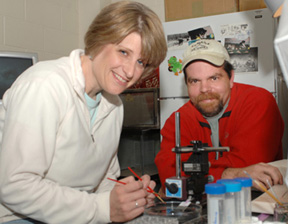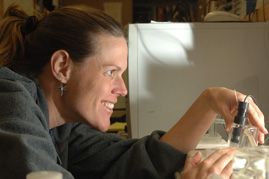Biology faculty team up with local prep teachers on research projects
July 25, 2008
Highland High School biology teacher Teri Mitton said recently she loves learning new things, as she was peering through a microscope attempting to slice off a 50-micron thick section of a pickled toad’s brain. She had plans to put the sample on a microscope slide for it to be examined in an Idaho State University biological sciences laboratory.  Meanwhile, on the same floor in the ISU Biological Sciences Building, Meg Fleischmann, who teaches anatomy and physiology and physical education classes at Century High School, was learning to separate mitochondria from the heart muscles of fish, and then analyze them. Mitochondria are tiny structures in most living cells that contain genetic material and enzymes important for cell metabolism and energy production.
Meanwhile, on the same floor in the ISU Biological Sciences Building, Meg Fleischmann, who teaches anatomy and physiology and physical education classes at Century High School, was learning to separate mitochondria from the heart muscles of fish, and then analyze them. Mitochondria are tiny structures in most living cells that contain genetic material and enzymes important for cell metabolism and energy production.
Mitton and Fleischmann, from rival Pocatello high schools, are both engaged in sophisticated research at Idaho State University and are being mentored by top ISU researchers. The two separate programs they are engaged in allow high school teachers to help conduct real, live, honest-to-goodness university-level research, and then share that learning process with their high school students.
Mitton, initially, wasn’t having much success mounting the tissue on the slides. Fifty microns is equal to about .05 millimeters, and, no matter how you slice it, is very thin.
“It’s not easy cutting that small of a piece of tissue,” noted Curtis Anderson, Ph.D., ISU biological sciences professor, who is Mitton’s mentor and supervisor this summer while she works on ISU research projects. “It takes a while to get the hang of it, and takes a lot of manual dexterity.”
 This skill is only one of many that Mitton, who has taught at Highland High the last 14 years, is mastering this summer while working in Anderson’s laboratory. Anderson is involved in a collection of studies that seek to understand how the brain coordinates movement. Mitton’s activities on this day related specifically to attempting to identify parts of the brain that are controlling the movement of jaw muscles in toads. She will be working 40 hours a week on this project for the bulk of the summer.
This skill is only one of many that Mitton, who has taught at Highland High the last 14 years, is mastering this summer while working in Anderson’s laboratory. Anderson is involved in a collection of studies that seek to understand how the brain coordinates movement. Mitton’s activities on this day related specifically to attempting to identify parts of the brain that are controlling the movement of jaw muscles in toads. She will be working 40 hours a week on this project for the bulk of the summer.
“She isn’t just doing busy work,” Anderson said, referring to Mitton’s activities. “She is helping me gather publishable data for my National Science Foundation grants, and she’ll be making a professional research presentation of her own at a national conference in New Orleans next spring.”
Mitton received a 2008 Frontiers in Physiology Professional Development Fellowship from the American Physiological Society. She receives a stipend from the APS this summer, and APS will fund her travel to the New Orleans’s research conference next spring, as well as a teaching workshop in Washington, D.C., in late summer.
“Too often labs designed for high school students just require them to come up with a correct number answer or specific outcome, and that isn’t what happens in real science,” Mitton said. “Based on this and similar experiences, it has changed the way I teach.”
“I’m really proud they selected ISU for a fellowship, right along side with Duke and Stanford,” Anderson said. “We have a good track record of working with local high school teachers and students in our labs.”

Another example of this “good track record” is the work of Fleischmann, who is employed in the laboratory of Ken Rodnick, Ph.D., another ISU professor in the biological sciences department. Fleischman received a $15,000 grant from the M.J. Murdock Charitable Trust of Vancouver, Wash., to conduct research the next two summers in the Rodnick’s lab, working on a study titled “Exploring Sex Differences in Cardiac Energy Metabolism and Function in Rainbow Trout: A tour from Isolated Mitochondria to Swimming Fish.”
Rodnick, an accomplished researcher, has attracted about $650,000 worth of National Science Foundation grants to ISU, and is currently working on a half dozen projects at Idaho State University, as well as collaborating on a variety of other studies with researchers at other universities.
“Many high school teachers read a lot about science but few of them really have time to actually do science,” Rodnick said. “In high schools, there is no time for research. My goal here is for them to see the effort and challenge to gather information to extend science, and to enlightened them on how we gain new knowledge through research.”
Rodnick, Fleischmann and Century High School student Ben Devaud (see accompanying story) are doing exactly that – extending science – in Rodnick’s lab. No one else, according to Rodnick, has separated and then examined the mitochondria of trout heart muscles to see differences between the sexes.
“This has been an absolutely positive experience,” Fleischmann said. “Dr. Rodnick has been an excellent teacher. He reviews concepts and makes it easy for me to understand, so I can go back to my students and teach them. This should be invaluable for my students.”
Categories:
